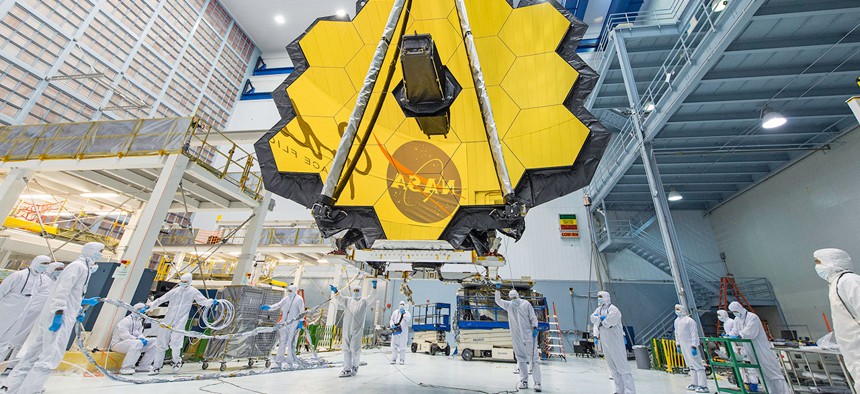The Shipping and Handling of a Gigantic Space Telescope
The James Webb will soon travel from Maryland to Texas, and the move requires a lot more than a “fragile” sticker slapped onto on the side of a box.
The James Webb Space Telescope is ready for the next step in its journey to becoming the most powerful space observatory ever, tasked with glimpsing the oldest stars and galaxies in the universe. NASA has finished testing the telescope’s 21-foot-tall, honeycomb-like gold-coated mirrors and scientific instruments at NASA’s facility in Maryland. Soon, the hardware will be packed up and shipped to Texas, where it will undergo even more tests before it’s launched into space in 2018.
But how exactly do you transport a giant, two-decades-in-the-making telescope worth billions of dollars?
“Short answer: very carefully,” said Eric Smith, Webb’s program director, in a recent interview.
The long answer is more involved. Inside the cleanroom at NASA’s Goddard Space Flight Center, Webb’s beryllium mirrors and instruments will be lifted by a crane from the ceiling. A technician on the floor, dressed in a full-body white suit to prevent contamination, maneuvers the crane using a joystick control box. (“They don’t just give anybody who’s played a video game a joystick and go, ‘have at it,’” Smith assured me.) Other technicians and scientists present, clad in the same suits, probably hold their breath.
The hardware is then lowered very, very, very slowly into a 165,000-pound shipping container that NASA had manufactured specifically for this purpose. The top of the container is secured, sealing Webb inside a climate-controlled sarcophagus. The container is rolled out of the cleanroom, fitted with hydraulic wheels, and attached to a semi-truck. The truck then drives south from Goddard to Joint Base Andrews, surrounded by a convoy of police and NASA employees. The trip usually takes about a half hour, but Webb is precious cargo. The truck will reach no more than 10 miles per hour, slowing to a crawl around turns or beneath underpasses.
By the way, this whole thing happens in the dead of night, when it’s easier for police to block off stretches of highway. After the truck arrives at the air base, it’s loaded into a C-5 military transport plane, an aircraft designed to carry tanks and fighter jets. The plane flies to the Ellington Field, a military base near Houston. The truck is unloaded and driven to Johnson Space Center. There, Webb’s mirrors and instruments will be dipped inside a test chamber, cooled by liquid nitrogen and helium to simulate the extreme cold of deep-space.
NASA won’t say when Webb will be making the big move, citing security reasons, but sometime in the next few weeks look likely.
The Webb team has had some practice. Last year, NASA transported a 3,000-pound replica of Webb’s backbone, which has stood in for the real thing in several tests, from Goddard to Johnson through the same process. The mirrors and instruments themselves have been lifted and shuffled around the Goddard facility to different rooms for acoustics and vibrations test, which simulate the sounds and shakes of a rocket launch. The team has folded and unfolded the hexagonal mirrors to make sure they will deploy properly in space.
By the time of launch, the James Webb will be a well-traveled piece of technology. The beryllium powder for the telescope’s mirrors was mined in mineral-rich mountains in Utah. From there, the beryllium has criss-crossed the country, making stops at various facilities in Ohio, Alabama, California, Colorado, and New Jersey to be shaped, polished, and tested. After it completes testing in Houston, the mirrors and instruments will travel to California, where they will assembled with a tennis court-sized sunshield and other hardware to become, finally, the James Webb Space Telescope. The completed telescope will be transported by ship through the Panama Canal and to French Guiana, where it will lift off on an Ariane 5 rocket.
Webb’s travels won’t end there. The telescope will reach a spot about 1 million miles away from Earth, where it will orbit the sun. When it unfolds, its gold mirrors will stare out into the darkness, looking farther back in time than humans ever have before, in search of light from the very first stars.




